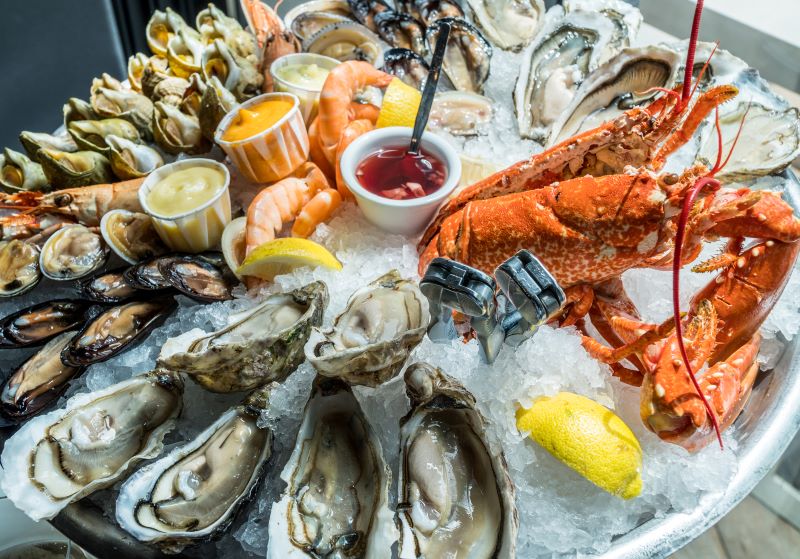Food Poisoning from Seafood

Generally, eating fully cooked food that is served hot helps you avoid foodborne disease, sometimes called food poisoning. However, there are a few types of foodborne diseases you can get from fish that cannot be prevented by cooking.
During travel if you think you have food poisoning from seafood seek medical care immediately.
Shellfish Poisoning
There are several types of toxins in contaminated shellfish that can cause illness. Toxins may be in found in mussels, oysters, clams, scallops, cockles, abalone, whelks, moon snails, Dungeness crab, shrimp, and lobster.
Shellfish usually become contaminated during or after algae blooms. Shellfish poisoning symptoms differ in severity and depend on the type of toxin in the shellfish. If you’ve recently eaten shellfish and develop the following symptoms, seek medical care.
Symptoms
Symptoms usually appear 30–60 minutes after eating contaminated shellfish, but it could be a few hours before you start to feel sick. Severe cases may be fatal. Symptoms vary based on the type of toxin in the shellfish and can include:
- Numbness and tingling
- Headache
- Nausea
- Vomiting
- Diarrhea
- Confusion
Prevention
Avoid potentially contaminated shellfish. If you’re visiting an area that’s recently experienced an algae bloom, sometimes called “red tide” or “brown tide,” avoid eating shellfish. You may want to avoid shellfish completely if you are traveling in a low-income country or if you aren’t confident of the water quality where the shellfish are from.
Ciguatera

You can get ciguatera (sig-wah-TARE-ah) poisoning by eating fish contaminated with toxins produced by tiny algae found around coral reefs. It can be difficult to tell if fish is contaminated as the toxins that cause ciguatera do not change the appearance, taste, or smell of the fish. Cooking does not destroy the toxins.
Ciguateria can accumulate in reef fish that eat other fish. Fish you may want to avoid include barracuda, moray eel, grouper, amberjack, sea bass, sturgeon, parrot fish, surgeonfish, and red snapper.
Signs and Symptoms
Ciguatera symptoms usually develop 3–6 hours after eating contaminated fish but may start up to 30 hours later. If you’ve recently eaten fish and develop symptoms, seek medical care.
Common symptoms include:
- Nausea
- Vomiting
- Diarrhea
- Stomach pain
Less common symptoms can include:
- Tingling
- Tooth pain or feeling as if teeth are loose
- Itching
- Metallic taste in the mouth
- Blurred vision
- Increased sensitivity to hot and cold
Symptoms usually last a few days but, in some cases, can linger for months. There is no cure for ciguatera, however there are treatments for some of the symptoms. After recovering you may want to avoid fish, nuts, alcohol, and caffeine for at least 6 months to prevent symptoms from returning.
Prevention

Avoid or limit eating fresh reef fish, especially barracuda and moray eel, as they are more likely to cause ciguatera. Do not eat the fish’s liver, intestines, eggs, or head because they have the highest concentration of toxins.
Scombroid
Scombroid (SKOM-broyd) poisoning is caused by eating fish that has not been properly refrigerated after being caught.
Scombroid occurs worldwide and is one of most common fish poisonings. Scombroid poisoning can occur from eating tuna, mackerel, mahi-mahi (dolphin fish), sardines, anchovies, herring, bluefish, amberjack, and marlin.
Signs and Symptoms
Scombroid symptoms usually develop within a few minutes to an hour after eating contaminated fish. They often resemble an allergic reaction and may include the following:
- Flushing of the face
- Headache
- Heart palpitations (fast-beating, fluttering, or pounding heart)
- Itching
- Blurred vision
- Cramps
- Diarrhea
Symptoms can be treated with antihistamines. Even without treatment, people usually get better within 12–48 hours
Prevention
The best way to avoid scombroid is to only eat fish that you know has been properly stored. Contaminated fish usually look and taste normal, but may taste peppery, sharp, or salty. Keep in mind that cooking, smoking, or freezing the fish does not prevent scombroid.
More Information
CDC Yellow Book: Food Poisoning from Marine Toxins